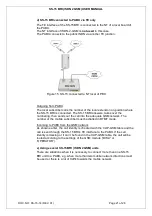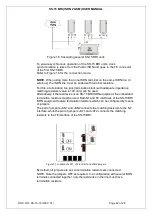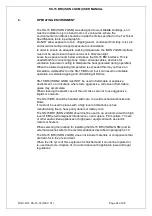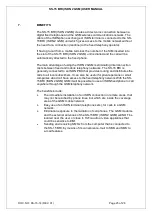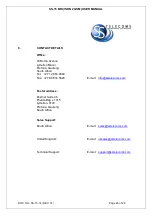
SS-15 BRI (ISDN 2 GSM) USER MANUAL
DOC. NO: SS-15-14 (REV. 01)
Page 18 of 26
SS-15 BRI, for that module a SIM with convenient tariff rate (low cost per minute
for a very large number of minutes used) may be used.
In case of connecting several SS-15 BRI (ISDN 2 GSM) units to an ISDN phone
exchange, the possibilities of routing calls for least costs are even better. Firstly,
there is no limitation to two GSM modules - modules with SIM cards for two or
three mobile providers may be used, each with different subscription that allows
a better tariff rate.
Secondly, if all GSM modules in an SS-15 BRI interface are engaged (busy), the
call to a mobile network may not only be rejected but instead routed through
another SS-15 BRI (ISDN 2 GSM) connected to the same PABX.
The Programming Tool uses CLIP to check the identity of the callers against a
data base. Thus calling can be restricted to certain selected (authorized)
subscribers, avoiding unnecessary costs.
Caller identification may be used for automated routing of calls.
All incoming calls that contain information about the phone number of the
subscriber (ID) will be checked by the Programming Tool against the CLIP
routing list. Depending upon the “Action” that has been set up, the program
will route the call accordingly, to the operator of the PBX, to a certain local
extension or will provide DISA tone.
DISA – direct inward access – allows callers to select the extension they want
without the help from an operator, via DTMF codes. Also, they can dial out of the
exchange.
If the incoming ID is missing, the default routing options apply.
With the “Nr. of Dialled Digits” option the SS-15 BRI makes the call
immediately after receiving the last digit - any digit sent afterwards will be
ignored.
5.2
MODES OF CONNECTION
There are a few options of connecting the SS-15 BRI equipment to an ISDN
phone exchange.
The ISDN 2 GSM interface can be connected either as TE, when it acts as a
terminal equipment, or as NT, when it simulates ISDN network.
It may also be used as a pass-through device that is “transparent” for the
calls. In this case the SS-15 BRI (ISDN 2 GSM) equipment is inserted
between the public ISDN network and the PBX.
These three basic modes of connecting the SS-15 BRI can be combined in
different ways, as shown further.
a) SS-15 BRI connected via NT to a TE junction of the PABX
The NT connector of the GSM-2-ISDN linked to the TE of the PABX.
The TE of the PABX goes to the public ISDN. The TE interface can be
used to get the clock signal for synchronization, as shown below.


















